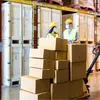
In a matter of months, the COVID-19 pandemic has altered our lifestyles entirely. Social distancing norms and several lockdowns implemented across the country have forced people to remain indoors.
It’s not only the common man; businesses have also been hit hard by the pandemic, ultimately resulting in the global economy taking a plunge.
Now, as the lockdown regulations ease and the economy gradually reopens, businesses are racing to compensate for the downturn even as the pandemic continues to wreak havoc on the world. The ecommerce logistics industry is no exception.
With several restraints on movement, the supply chain faced major disruptions and logistics players faced challenges in meeting the escalating demand, particularly for essential items during the lockdown.
While the pandemic has been a barrier in many ways, especially for small sellers, there have been perks for the logistics industry even amidst the crisis.
The outbreak has presented innumerable opportunities for innovation and improvisation for the logistics sector. One such opportunity has been introduced by the uptick in hyperlocal deliveries. Hyperlocal deliveries have been a blessing in disguise for logistics players, aggregators, and customers.
Let us take a look at what hyperlocal deliveries are and how the logistics industry is leveraging them to stay afloat in the market during the COVID-19 era.
What are hyperlocal delivery services?
Hyperlocal deliveries constitute services in which the seller/service provider acquires products requested by the customer locally and delivers them within the same geographical area.
It is a business model in which local offline businesses are connected to the end customer through a digital platform, enabling quick deliveries since it covers short distances. Hyperlocal deliveries are being increasingly preferred by brands in the logistics industry owing to the convenience they offer.
D2C model: Connecting sellers to customers
Small sellers often do not have the infrastructure to connect with their customers directly through digital platforms, especially if they are catering to various geographies, even within a city.
Hyperlocal delivery services serve customers within set geographies. The objective is to connect sellers with all potential and existing customers within that region. Logistics aggregators facilitate this direct connection between the seller and the customer, offering a classic win-win situation for both parties.
Transparency and real-time updates for smooth last-mile deliveries
Many of us often track the dispatch and delivery status of the product soon after we place the order. More often than not, the delivery of the product might be delayed despite the app/website showing that it is out for delivery.
The key reason is inefficiency, lack of real-time updates, and Non-Delivery Reasons (NDR). Up until recently, offline sellers had no way of tracking the shipment, and thus could not have stayed updated regarding the status of delivery.
With cutting-edge technologies such as AI/ML, aggregators are now ensuring that real-time updates and Non-Delivery Reasons are being provided to the seller, which will help them keep customer updated, provide a modicum of transparency, and increase customer satisfaction.
Sellers can track the package until it reaches the customer’s doorstep, making for a seamless last-mile delivery process that is highly transparent. Since hyperlocal deliveries cater to a specific geographical area, it makes the entire process easier for all parties involved.
Cost, time, and resource optimisation
When it comes to adopting the hyperlocal delivery model, optimisation of cost, time, and resources are some of the key advantages.
While considering this model, due to short delivery distances, sellers can provide super-fast deliveries at a reduced cost through experienced delivery partners - highly beneficial when trying to meet the heightened demand during the ongoing pandemic.
This will also result in fewer resources such as delivery executives being since time is saved on the distance travelled, enabling sellers to cater to a greater number of customers. Aggregators even offer nominal prices based on the weight of the shipment, which means that small sellers do not need to invest enormous amounts of money on shipping.
To sum things up, hyperlocal deliveries have become a one-stop solution for small sellers and aggregators alike, and the rising demand is only further driving the adoption of hyperlocal services upwards. While the pandemic is a temporary scenario, it appears that hyperlocal delivery services are here to stay for a long time.
(Edited by Teja Lele)
(Disclaimer: The views and opinions expressed in this article are those of the author and do not necessarily reflect the views of YourStory.)
Want to make your startup journey smooth? YS Education brings a comprehensive Funding Course, where you also get a chance to pitch your business plan to top investors. Click here to know more.
Link : https://yourstory.com/2020/08/hyperlocal-delivery-market-logistics-technology-covid-19
Author :- Saahil Goel ( )
August 18, 2020 at 11:18AM
YourStory


